Temporary Flight Restrictions (TFRs) are a common term in aviation, but understanding their impact on different types of flights, especially scheduled airlines, is crucial for pilots and anyone involved in air travel. If you’ve ever wondered, “Can scheduled airline flights fly in a TFR?”, the answer is nuanced and depends heavily on the specific nature of the TFR.
Just like the name suggests, a Temporary Flight Restriction is a short-term limitation placed on airspace, tightening the rules and parameters for flying within a defined area. These restrictions aren’t arbitrary; they are implemented for a variety of reasons, all centered around safety and security. The level of restriction can vary significantly – some TFRs might permit flight operations with stricter regulations, while others completely prohibit entry into the designated airspace.
For those less familiar with TFRs, questions abound. Is flying through a TFR ever allowed? What are the repercussions of unintentionally entering restricted airspace? And most importantly, how can pilots stay informed about active TFRs to ensure compliance?
This article will delve into the different categories of TFRs, the regulations governing each type, and address the critical question of whether scheduled airline flights can operate within these restricted zones. We will also explore the consequences of violating TFRs and how pilots, including those operating commercial airlines, can navigate these temporary airspace limitations effectively.
Types of Temporary Flight Restrictions (TFRs)
The reasons behind implementing a TFR are diverse, reflecting the dynamic nature of airspace management and the need to respond to various situations. These reasons are categorized into eight primary types, each with its own specific purpose and set of regulations.
The 8 main categories of TFRs are:
- Disaster/Hazard Areas: Protecting people, property, and low-flying aircraft from immediate dangers.
- National Disaster Areas in the State of Hawaii: Similar to disaster/hazard areas, but specifically for national disasters within populated areas of Hawaii.
- Emergency Air Traffic Rules: Activated during emergencies when the FAA’s ATC system is compromised, ensuring aviation safety during widespread disruptions.
- Presidential and Other Parties (VIP): Securing airspace around the President, Vice President, and other designated VIPs.
- Space Flight Operations: Ensuring safety during space launches and re-entries, particularly around spaceports.
- Abnormally High Barometric Pressure Conditions: Preventing flight in areas where extreme atmospheric pressure can cause altimeter inaccuracies.
- Management of Aircraft Operations in the Vicinity of Aerial Demonstrations and Major Sporting Events: Providing safe airspace for airshows and large public gatherings.
- Special Security Instructions: Protecting sensitive locations and events of national security interest from potential threats.
Disaster/Hazard Areas
Disaster/Hazard Area TFRs are implemented to mitigate risks associated with various emergencies. These can range from natural disasters like wildfires, earthquakes, hurricanes, and volcanic eruptions to man-made hazards such as toxic chemical spills, nuclear accidents, and aircraft crashes. The primary goal is to safeguard both individuals and properties on the ground, as well as aircraft operating at lower altitudes that might be vulnerable to these hazards.
These TFRs also establish a safe distance around critical infrastructure that stores hazardous materials, minimizing the potential for accidents to escalate. Detailed regulations and restrictions for disaster/hazard area TFRs can be found in Section 91.137 of the Federal Aviation Regulations (FARs).
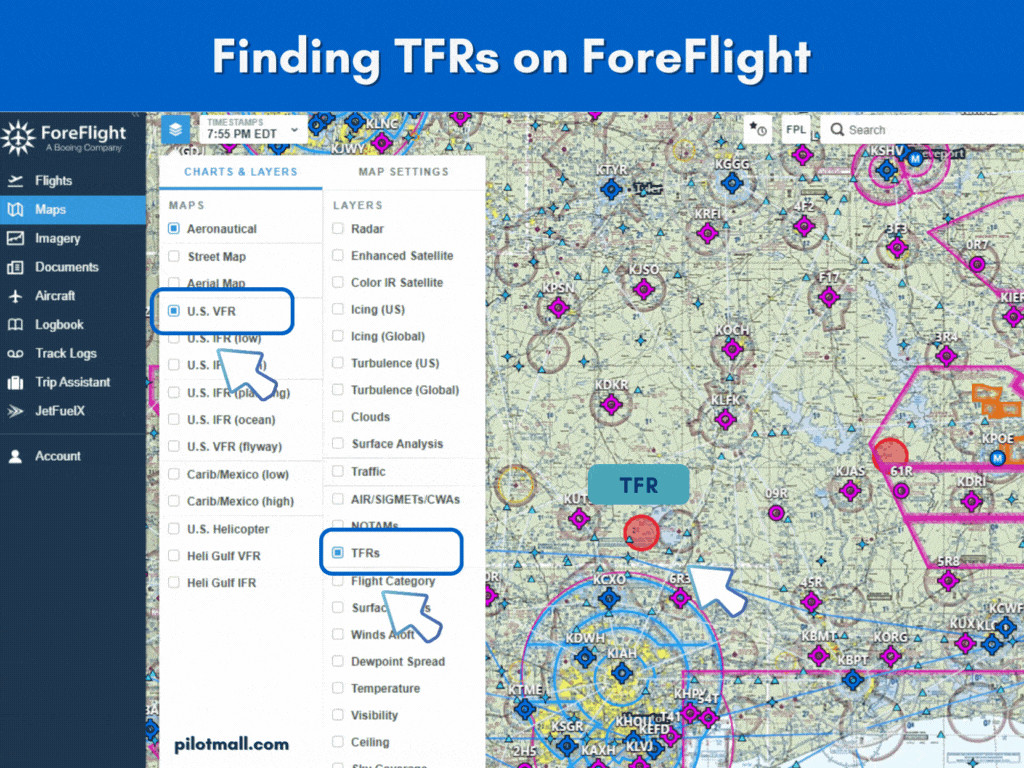 Wildfire Disaster Hazard TFR
Wildfire Disaster Hazard TFR
Impact on Scheduled Airline Flights: In disaster scenarios, scheduled airlines are highly likely to be affected. Airports within or near disaster areas might be closed, and flight paths could be altered to avoid hazard zones. Airlines will prioritize safety and adhere strictly to these TFRs, potentially leading to flight delays and cancellations. However, in some cases, airlines might be authorized to operate essential flights (e.g., humanitarian aid, evacuation) in coordination with ATC, even within or near a disaster TFR zone, under stringent conditions.
National Disaster Areas in the State of Hawaii
Specific to the state of Hawaii, this type of TFR mirrors the disaster and hazard area TFR but is tailored to national disasters declared in Hawaii’s inhabited regions. The aim remains the same: to protect people and property within a designated national disaster zone. For more in-depth information on these Hawaii-specific TFRs and their regulations, refer to Section 91.138 of the FARs.
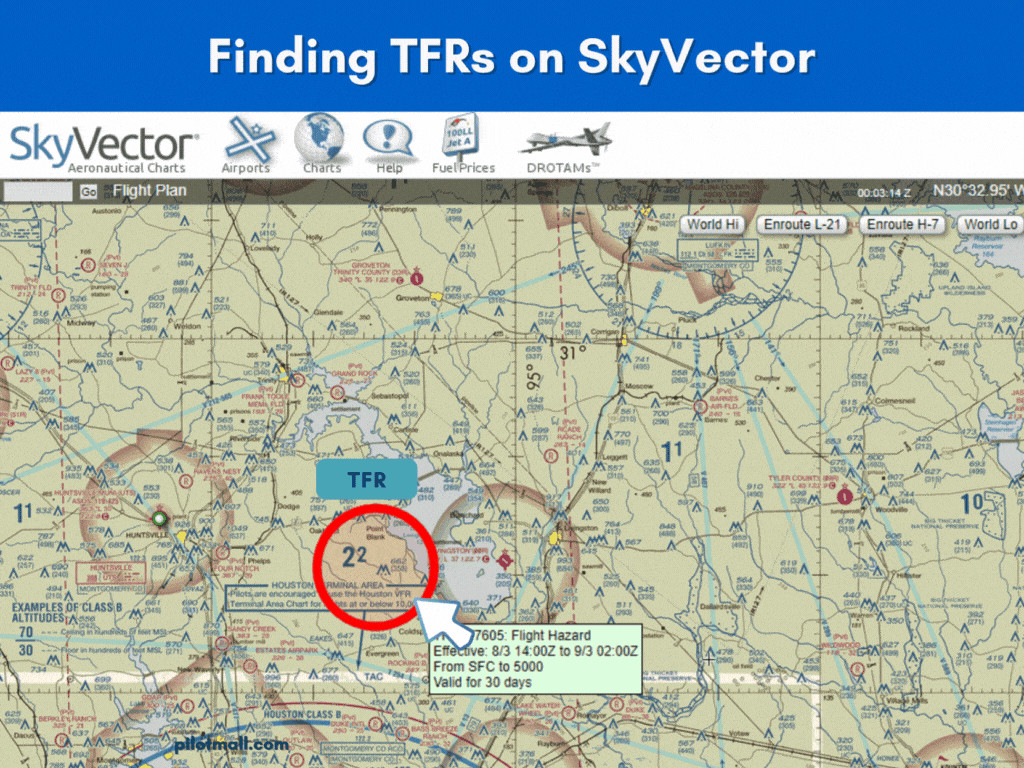 SkyVector TFR Display Hawaii
SkyVector TFR Display Hawaii
Impact on Scheduled Airline Flights: Similar to general disaster TFRs, these will significantly impact scheduled airlines operating to, from, and within Hawaii. Flight disruptions, including cancellations and diversions, are expected during national disasters. Airlines will work closely with ATC and aviation authorities to ensure passenger safety and operational adjustments.
Emergency Air Traffic Rules
Emergency Air Traffic Rules TFRs are invoked during widespread emergencies that cripple the FAA’s Air Traffic Control (ATC) system. These are extreme measures, implemented when normal flight operations cannot be conducted safely and efficiently on a larger scale.
A stark example of this TFR type was the nationwide grounding of all air traffic in the United States following the September 11th attacks. Section 91.139 of the FARs provides further details on emergency air traffic rules TFRs and their specific restrictions.
Impact on Scheduled Airline Flights: This type of TFR has the most drastic effect on scheduled airlines, potentially leading to a complete halt of operations. Airlines would be forced to ground their fleets and suspend all scheduled flights until the emergency is resolved and the TFR is lifted. Resuming operations would require careful coordination with ATC to manage the backlog and ensure a safe return to normal schedules.
Presidential and Other Parties (VIP)
Perhaps the most operationally challenging TFR for pilots, including those of scheduled airlines, is the Presidential and other VIP TFR. These TFRs establish a restricted flight zone around the President, Vice President, and other designated VIPs as they travel. The dynamic and mobile nature of these TFRs sets them apart from more static types.
VIP TFRs are often described as “roving” because they move with the protected individuals. Although NOTAMs for VIP TFRs specify expected start and end times, these times can change with little notice if the VIP’s schedule shifts. This unpredictability requires pilots to be constantly vigilant and check for updates to avoid unintentionally entering a VIP TFR zone. More information on presidential and VIP TFRs can be found in Section 91.141 of the FARs.
Impact on Scheduled Airline Flights: VIP TFRs can cause significant disruptions to scheduled airlines. Airports in the vicinity of VIP movement may face temporary closures or airspace restrictions, leading to delays, diversions, and gate holds. Airlines must closely monitor NOTAMs and ATC updates to adjust flight plans and minimize passenger inconvenience while ensuring compliance with these security-driven TFRs.
Space Flight Operations
Areas around spaceports, such as Cape Canaveral in Florida, are prime locations for space flight operations TFRs. Whenever space agencies like NASA conduct launches, TFRs are issued to protect the airspace required for safe launch and landing operations. Similar TFRs are also common in New Mexico and California, other states with active spaceflight programs. Detailed information on space flight operations TFRs and their regulations can be found in Section 91.143 of the FARs.
Impact on Scheduled Airline Flights: Space flight operations TFRs typically have a localized impact but can still affect scheduled airlines. Flight paths over or near spaceports may be rerouted during launch windows, potentially causing minor delays. Airlines operating near these areas need to be aware of scheduled space activities and associated TFRs to plan their routes accordingly.
Abnormally High Barometric Pressure Conditions
Aircraft altimeters rely on barometric pressure to determine altitude. However, in conditions of extremely high barometric pressure, often caused by cold, dry air masses, standard aircraft barometers, which typically measure up to 31 inches of mercury, can become inaccurate. Flying in such conditions becomes hazardous.
To prevent accidents, TFRs are issued to keep aircraft out of areas experiencing abnormally high barometric pressure until conditions stabilize. Further details on these TFRs are available in Section 91.144 of the FARs.
Impact on Scheduled Airline Flights: High barometric pressure TFRs are less common but can affect airline operations, particularly at airports in regions prone to these weather conditions. Airlines would need to adjust flight schedules and routes to avoid these areas, potentially leading to delays and altitude adjustments for flights in the vicinity.
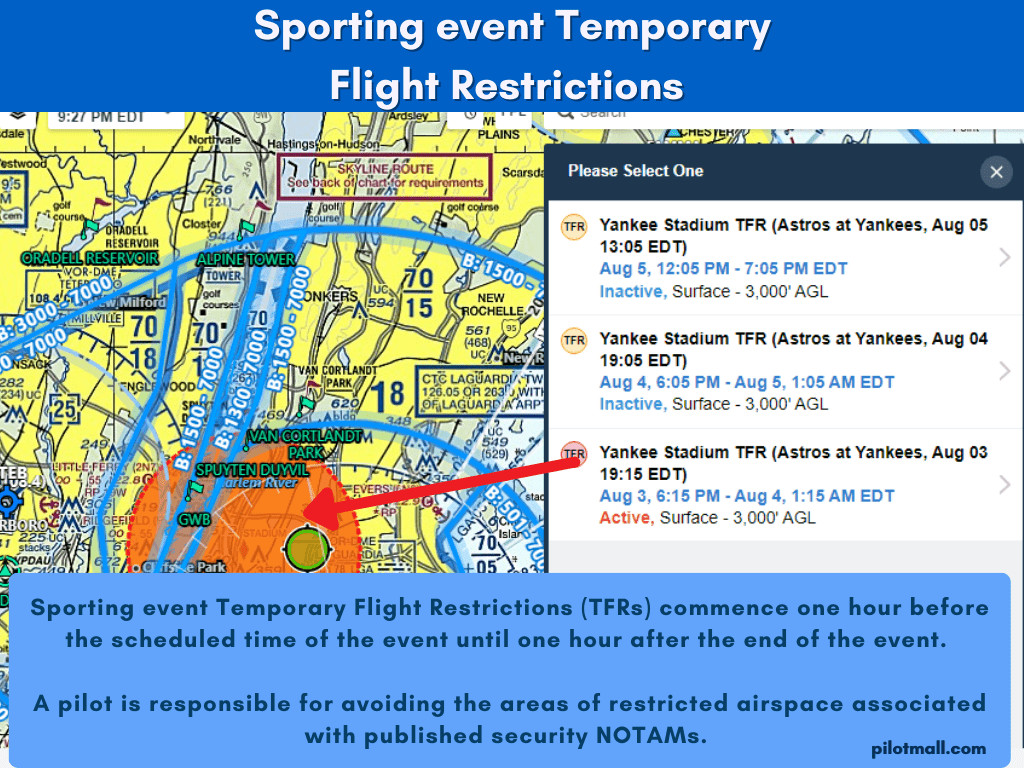 Sporting Event TFR Example
Sporting Event TFR Example
Management of Aircraft Operations in the Vicinity of Aerial Demonstrations and Major Sporting Events
Aerial demonstrations and airshows require dedicated, protected airspace for safe operation. Similarly, major sporting events like the Olympics, Super Bowl, or World Series often involve authorized aircraft overhead for broadcasting or security. To ensure safety at these events, special event TFRs are implemented.
While some sporting events with TFRs are listed in the FARs, TFRs can be issued for a wide range of high-attendance events. Section 91.145 of the FARs provides more information on special event TFRs.
Impact on Scheduled Airline Flights: Sporting event TFRs generally have minimal impact on scheduled airlines as they are typically localized around the event venue and for a limited duration. Airline routes are usually planned to avoid these areas, and any necessary adjustments are minor and unlikely to cause significant disruptions.
Special Security Instructions
Special Security Instruction TFRs are designed to protect airspace over locations deemed sensitive to national security or potential terrorism targets. These TFRs are frequently established around military bases, critical infrastructure, political conventions, and during visits by foreign dignitaries.
Security TFRs can be used in conjunction with other TFR types, such as space flight or special event TFRs, to enhance overall airspace security. They are also used to restrict drone operations over sensitive installations. Section 99.7 of the FARs provides details on special security instructions TFRs.
Impact on Scheduled Airline Flights: Special security TFRs can have varying degrees of impact on scheduled airlines. TFRs around major cities or critical infrastructure could lead to rerouting of flight paths, potential delays, and increased security procedures at airports. Airlines must comply strictly with these TFRs, especially those related to national security, and may need to adjust operations based on the specific restrictions in place.
History of TFRs
Before the events of 9/11, TFRs were primarily used for safety reasons, with occasional restrictions for Presidential movements. However, the heightened security concerns following 9/11, along with updates to the CFRs allowing TFRs for major sporting events and airshows, led to a significant increase in the number of TFRs. The rise in large forest fires has also contributed to the more frequent implementation of TFRs.
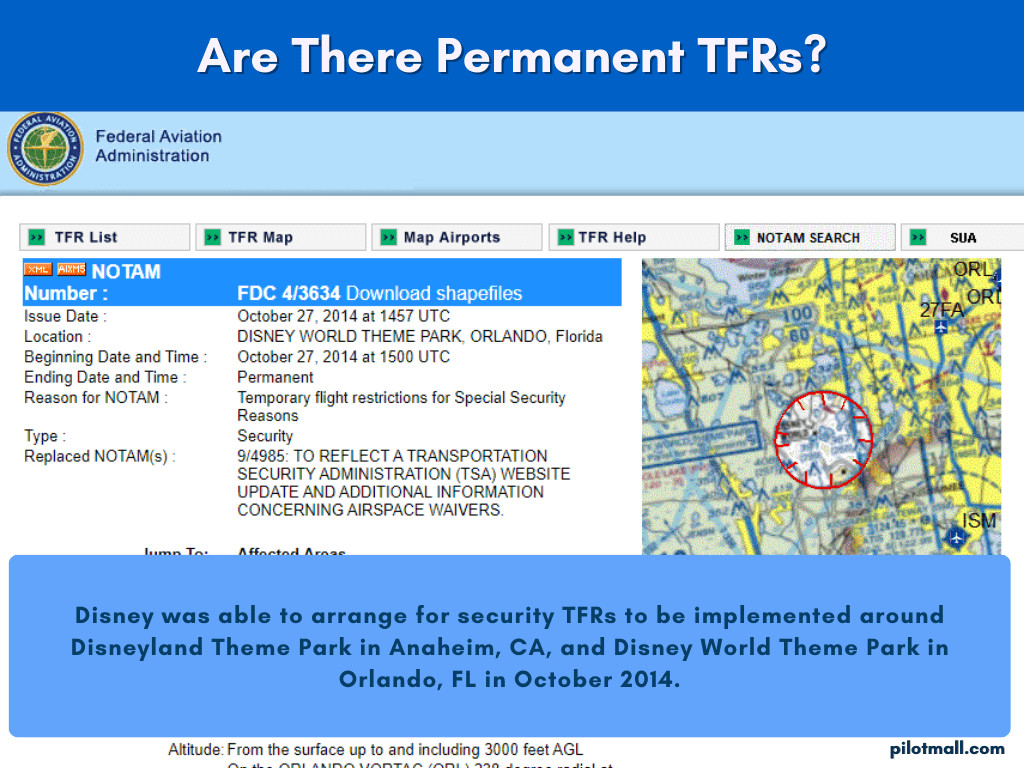 Permanent TFR Question
Permanent TFR Question
Is there such a thing as a permanent TFR?
The term “Temporary” Flight Restriction naturally suggests that these restrictions are not permanent. Generally, this is true; areas with permanent flight limitations are classified as prohibited or restricted airspace. However, there are notable exceptions where TFRs are in place indefinitely, effectively functioning as permanent restrictions.
These “permanent” TFRs list “permanent” as their end date and time. Examples include a VIP TFR near Dallas, Texas, protecting former President George W. Bush’s ranch since 2009, and another over Trump Tower in New York City since 2017. Beyond presidential protection, Disney theme parks (Disneyland in Anaheim, CA, and Disney World in Orlando, FL) also have security TFRs in place since October 2014.
Impact on Scheduled Airline Flights: Permanent TFRs generally become integrated into standard flight planning. Airlines are aware of these long-term restrictions and incorporate them into their route planning and operational procedures. The impact on daily operations is minimal as flight paths are designed to avoid these permanently restricted zones.
How do you know where the TFRs are?
Staying informed about active TFRs is a fundamental responsibility for all pilots, including those flying scheduled airlines. The most straightforward way to check for TFRs is through the FAA’s online list of current TFRs. Since TFRs are a type of NOTAM (Notice to Air Missions), they can also be accessed via the FNS NOTAM search.
It is crucial for pilots to check for TFRs immediately before each flight by contacting their local Flight Service Station (FSS). This ensures they have the most up-to-date information, as some TFRs, especially those for VIP movements or high barometric pressure, can appear and disappear rapidly. Conversely, security-related TFRs may remain in effect for extended periods.
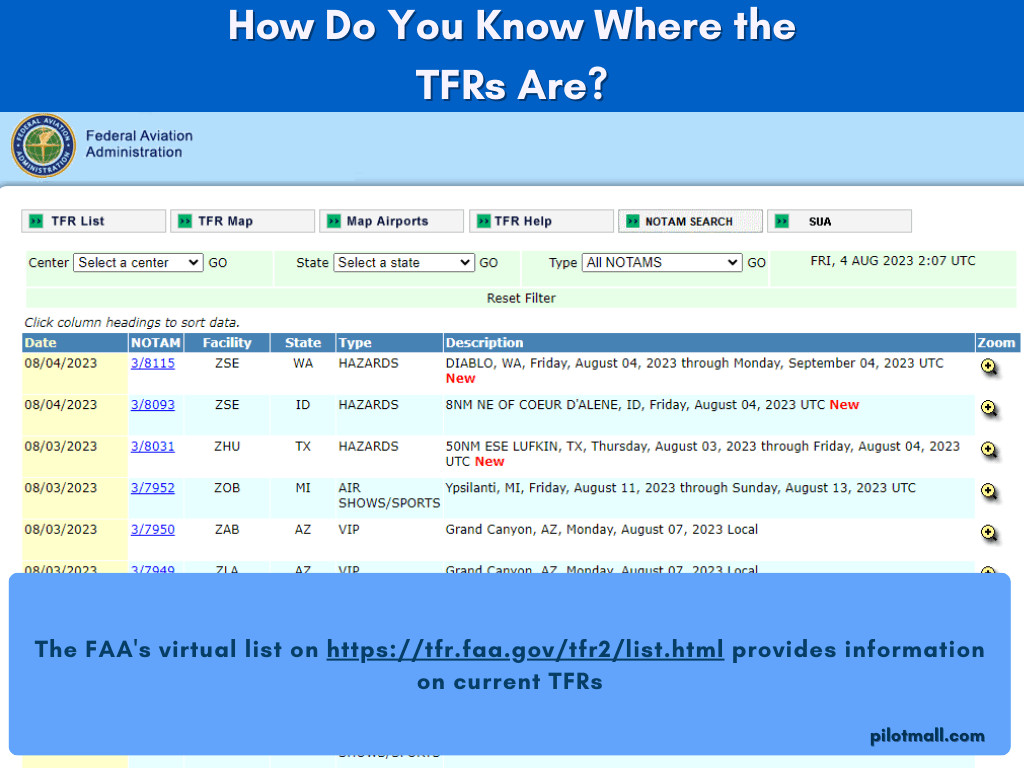 Finding TFR Information Online
Finding TFR Information Online
For Scheduled Airline Flights: Airlines have dedicated dispatch and flight planning departments that continuously monitor NOTAMs and TFRs as part of their pre-flight and in-flight procedures. Airline pilots rely on this information, as well as real-time updates from ATC, to ensure compliance and safe navigation.
Can you fly through a TFR?
The existence of a TFR doesn’t automatically mean airspace within its boundaries is completely off-limits. In many cases, aircraft can enter TFR airspace if they adhere to specific restrictions and meet requirements outlined in the NOTAM.
TFR airspace can be structured with inner and outer areas, each with different restrictions. Pilots must carefully read the NOTAM for each TFR to understand the applicable operating restrictions and requirements.
Check the NOTAMs
The NOTAM will specify the reason for the TFR (e.g., “firefighting operations”), the TFR type (e.g., “Hazards”), and the operating restrictions. A restriction like “No pilots may operate an aircraft in the areas covered by this NOTAM (except as described)” without further exceptions means the TFR is a complete no-fly zone.
Stay in communication with ATC
Some TFRs allow aircraft to operate within the restricted airspace if they meet certain conditions, such as having an active flight plan, using a discrete squawk code, and maintaining continuous two-way radio communication with ATC.
This is common in TFRs with inner and outer rings of restricted airspace. The outer ring might permit transit for “talking and squawking” aircraft, while the inner ring remains completely restricted to participating aircraft, law enforcement, and military.
In other cases, NOTAMs might include the phrase “unless authorized by ATC,” offering some flexibility. Pilots with a valid reason to enter the TFR airspace can request permission from ATC.
Navigating TFR rules can be complex. Consulting with an FSS can clarify ambiguities. For VFR flights near TFR areas, requesting flight following is a proactive strategy to avoid airspace violations.
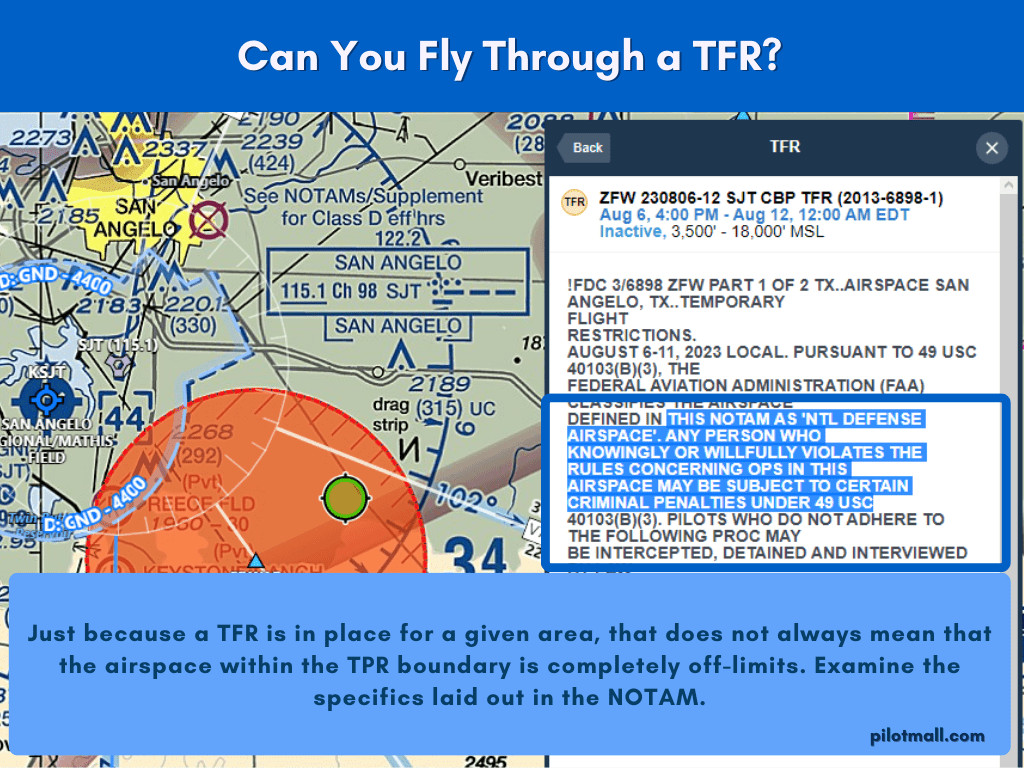 TFR Flight Permission Question
TFR Flight Permission Question
For Scheduled Airline Flights: Scheduled airlines generally operate under Instrument Flight Rules (IFR) and are in constant communication with ATC. While scheduled airline flights are not automatically exempt from TFRs, they are more likely to be authorized to operate within certain TFR zones, particularly outer rings, under ATC control. For highly restrictive TFRs (inner rings, high-security zones), airlines would strictly adhere to the restrictions unless specifically authorized for essential operations (e.g., emergency landings, diversions due to unforeseen circumstances) by ATC and relevant authorities. Airline dispatchers and pilots are trained to interpret NOTAMs and communicate with ATC to ensure compliance and seek necessary clearances when operating near or within TFR areas.
What happens if you fly into a TFR?
Even with diligent pre-flight checks, unintentional TFR incursions can occur. Violating a TFR is a regulatory offense classified as a pilot deviation, triggering an FAA investigation and potential enforcement actions.
The consequences of a TFR violation depend on the TFR type, the nature of the infraction, and the pilot’s intent. Penalties can range from:
- Pilot’s license suspension or revocation
- Fines up to $100,000
- Civil penalties
- Criminal penalties, including up to one year in federal prison
Violations of Special Security and Presidential/VIP TFRs carry the most severe consequences, especially if deemed knowing or willful. A deliberate incursion into these zones can result in substantial fines, imprisonment, or both. In extreme cases, pilots might face interception by military fighter jets to ascertain intent and potential threat level.
The FAA provides a guide to National Security and Interception Procedures outlining interception signals and expected responses for intercepted aircraft, which can be crucial knowledge in such situations.
Unintentional TFR violations typically result in less severe but still significant penalties, often including license suspensions ranging from 30 to 90 days.
 TFR Violation Consequences Question
TFR Violation Consequences Question
For Scheduled Airline Flights: TFR violations by scheduled airlines are rare due to stringent operational procedures and constant ATC communication. However, if a violation occurs, the consequences are equally serious for airline pilots and the airline itself. In addition to pilot penalties, airlines can face hefty fines and reputational damage. Airline pilots undergo extensive training on airspace regulations and TFR procedures to minimize the risk of violations. Any TFR incursion by a scheduled flight would trigger immediate investigation by both the FAA and the airline, with potential disciplinary actions and procedural reviews to prevent future occurrences.
Takeaways
Temporary Flight Restrictions are essential tools for managing airspace safety and security for a multitude of reasons, from natural disasters to national security events. Pilots must maintain a high level of TFR awareness in their intended flight areas. Thorough NOTAM reviews and FSS consultations before every flight are critical. Flight following can also provide an added layer of safety and situational awareness near TFR zones.
The penalties for TFR violations underscore their seriousness, ranging from license suspensions to significant fines and even imprisonment. Understanding TFR types, regulations, and how they affect different types of flights, including scheduled airlines, is paramount for all aviation professionals.
Ultimately, answering the question “Can airlines fly in TFRs?” requires understanding that while scheduled airlines are not exempt, they operate within a framework of strict regulations, constant ATC communication, and robust flight planning procedures that minimize the likelihood of violations and maximize safety even in complex airspace environments. Staying informed and compliant is the key to safe and responsible flying.
To ensure you are fully up-to-date with aviation regulations, consult the Federal Aviation Regulations.